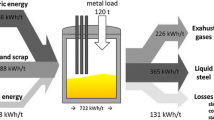Abstract
The experimental I–V characteristics of a Si cell module in a thermophotovoltaic (TPV) system were investigated using SiC or Yb2O3 radiator. The results demonstrate that the short-circuit current increases while the open-circuit voltage, along with the fill factor, decreases with the cell temperature when the radiator temperature increases from 1273 to 1573 K, leading to a suppressed increase of the output power of the system. The maximum output power density of the cell module is 0.05 W/cm2 when the temperature of the SiC radiator is 1573 K, while the electrical efficiency of the system is only 0.22%. The efficiency is 1.3% with a Yb2O3 radiator at the same temperature, however, the maximum output power density drops to 0.03 W/cm2. The values of the open-circuit voltage and the maximum output power obtained from the theoretical model conform to the experimental ones. But the theoretical short-circuit current is higher because of the existence of the contact resistance inside the cell module. In addition, the performance and cost of TPV cogeneration systems with the SiC or Yb2O3 radiator using industrial high-temperature waste heat were analyzed. The system electrical efficiency could reach 3.1% with a Yb2O3 radiator at 1573 K. The system cost and investment recovery period are 6732 EUR/kWel and 14 years, respectively.
Similar content being viewed by others
References
Fraas L M, Minkin L. TPV history from 1990 to present & future trends. AIP Conference Proceedings, 2007, 890(1): 17–23
Lange R G, Carroll W P. Review of recent advances of radioisotope power systems. Energy Conversion and Management, 2008, 49(3): 393–401
Butcher T A, Hammonds J S, Horne E, Kamath B, Carpenter J, Woods D R. Heat transfer and thermophotovoltaic power generation in oil-fired heating systems. Applied Energy, 2011, 88(5): 1543–1548
Xuan Y M, Chen X, Han Y G. Dsign and analysis of solar thermophotovoltaic systems. Renewable Energy, 2011, 36(1): 374–387
Yang W, Chou S, Chua K, An H, Karthikeyan K, Zhao X. An advanced micro modular combustor-radiator with heat recuperation for micro-TPV system application. Applied Energy, 2012, 97: 749–753
Saidov M S. Photothermoelectric cell for thermophotovoltaic systems and solar power plants with concentrators. Applied Solar Energy, 2012, 48(2): 67–70
Mostafa S I, Rafat N H, El-Naggar S A. One-dimensional metallic-dielectric (Ag/SiO2) photonic crystals filter for thermophotovoltaic applications. Renewable Energy, 2012, 45: 245–250
Conley B R, Naseem H, Sun G, Sharps P, Yu S Q. High efficiency MJ solar cells and TPV using SiGeSn materials. In: Proceedings of 2012 38th IEEE Photovoltaic Specialists Conference (PVSC). Austin, USA, 2012, 1189–1192
Bauer T, Forbes I, Pearsall N. The potential of thermophotovoltaic heat recovery for the UK industry. International Journal of Ambient Energy, 2004, 25(1): 19–25
Li Y H, Wu C Y, Lien Y S, Chao Y C. Development of a high-flame-luminosity thermophotovoltaic power system. Chemical Engineering Journal, 2010, 162(1): 307–313
Singh P, Singh S N, Lal M, Husain M. Temperature dependence of I–V characteristics and performance parameters of silicon solar cell. Solar Energy Materials and Solar Cells, 2008, 92(12): 1611–1616
Chakrabarty K, Singh S N. Depletion layer resistance and its effect on I–V characteristics of fully- and partially-illuminated siicon solar cells. Solid-State Electronics, 1996, 39(4): 577–581
Chubb D L. Fundamentals of Thermophotovoltaic Energy Conversion. Netherlands: Elsevier Science, 2007
Coutts T J. A review of progress in thermophotovoltaic generation of electricity. Renewable Sustainable Energy Reviews, 1999, 3(2,3): 77–184
De Soto W, Klein S A, Beckman W A. Improvement and validation of a model for photovoltaic array performance. Solar Energy, 2006, 80(1): 78–88
Jain A, Kapoor A. A new method to determine the diode ideality factor of real solar cell using Lambert W-function. Solar Energy Materials and Solar Cells, 2005, 85(3): 391–396
Mao L, Ye H, Cheng Q. Numerical analysis of the thermal radiation-electricity module of TPV system. Chinese Journal of Computational Physics, 2008, 25(4): 450–457 (in Chinese)
Palfinger G, Bitnar B, Durisch W, Mayor J C, Grützmacher D, Gobrecht J. Cost estimates of electricity from a TPV residential heating system. In: Proceedings of the 5th Conference on Thermophotovoltaic Generation of Electricity. Rome, Italy, 2003, 653: 29–37
Author information
Authors and Affiliations
Corresponding author
Rights and permissions
About this article
Cite this article
Wang, J., Ye, H., Wu, X. et al. Experimental investigation and feasibility analysis of a thermophotovoltaic cogeneration system in high-temperature production processes. Front. Energy 7, 146–154 (2013). https://doi.org/10.1007/s11708-013-0253-y
Received:
Accepted:
Published:
Issue Date:
DOI: https://doi.org/10.1007/s11708-013-0253-y




